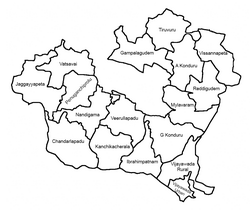Vijayawada Rural mandal: Difference between revisions
(map update) |
Kamal Guha (talk | contribs) (Krishna district -> NTR district) |
||
| Line 54: | Line 54: | ||
}} | }} | ||
'''Vijayawada (rural) mandal''' is one of the 20 [[mandal]]s in [[NTR district]] of the [[India]]n state of [[Andhra Pradesh]]. It is under the administration of [[ | '''Vijayawada (rural) mandal''' is one of the 20 [[mandal]]s in [[NTR district]] of the [[India]]n state of [[Andhra Pradesh]]. It is under the administration of [[Vijayawada revenue division]] and has its headquarters at [[Nunna]].<ref name=map>{{cite web |title=Krishna District Mandals|url=http://www.censusindia.gov.in/2011census/maps/atlas/28part31.pdf |publisher=Census of India|access-date=21 January 2015|pages=494, 526|format=PDF}}</ref><ref>{{cite web|title=Administrative Setup|url=http://krishna.nic.in/admin-setup.aspx|publisher=Krishna District Official Website|access-date=15 October 2014}}</ref> The mandal is bounded by [[Ibrahimpatnam mandal, Krishna district|Ibrahimpatnam]], [[G. Konduru mandal|G. Konduru]], [[Gannavaram mandal|Gannavaram]], [[Kankipadu]], [[Penamaluru mandal|Penamaluru]] and [[Vijayawada East mandal|Vijayawada East]] Mandals.<ref>{{cite web|title=Mandals in Krishna district|url=http://www.aponline.gov.in/quick%20links/apfactfile/info%20on%20districts/krishna.html|publisher=aponline.gov.in|access-date=28 July 2014|archive-url=https://web.archive.org/web/20141213093713/http://www.aponline.gov.in/quick%20links/apfactfile/info%20on%20districts/krishna.html|archive-date=13 December 2014|url-status=dead|df=dmy-all}}</ref> The mandal is also a part of the [[Andhra Pradesh Capital Region]] under the jurisdiction of Andhra Pradesh Capital Region Development Authority.<ref name=apcrda>{{cite web|title=Andhra Pradesh Capital Region Development Authority Act, 2014|url=http://www.news19.in/wp-content/uploads/2014/12/go-no-253.pdf|website=News19|publisher=Municipal Administration and Urban Development Department|access-date=9 February 2015|format=PDF|date=30 December 2014|archive-url=https://web.archive.org/web/20150218201933/http://www.news19.in/wp-content/uploads/2014/12/go-no-253.pdf|archive-date=18 February 2015|url-status=dead|df=dmy-all}}</ref> | ||
== Demographics == | == Demographics == | ||
| Line 76: | Line 76: | ||
}} | }} | ||
''Note: M- | ''Note: M-Municipality, (CT)-[[Census town]], OG-Out Growth''<ref>{{cite web|title=Some Concepts and Definitions|url=http://censusindia.gov.in/2011-prov-results/paper2/data_files/kerala/13-concept-34.pdf|publisher=Census of India 2011|access-date=19 January 2015}}</ref> | ||
== See also == | == See also == | ||
| Line 84: | Line 84: | ||
{{Reflist}} | {{Reflist}} | ||
{{NTR district-geo-stub}} | |||
{{Geographic location | {{Geographic location | ||
|Centre = Vijayawada (rural) mandal | |Centre = Vijayawada (rural) mandal | ||
| Line 95: | Line 96: | ||
|Northwest = [[G. Konduru]] mandal | |Northwest = [[G. Konduru]] mandal | ||
}} | }} | ||
{{NTR district}} | |||
[[Category:Mandals in NTR district]] | [[Category:Mandals in NTR district]] | ||
Revision as of 18:53, 10 September 2023
Vijayawada (rural) mandal | |
|---|---|
 Mandal map of NTR district | |
| Coordinates: 16°32′45″N 80°34′12″E / 16.54583°N 80.57000°ECoordinates: 16°32′45″N 80°34′12″E / 16.54583°N 80.57000°E | |
| Country | India |
| State | Andhra Pradesh |
| District | NTR |
| Headquarters | Nunna |
| Area | |
| • Total | 153.97 km2 (59.45 sq mi) |
| Population (2011)[1] | |
| • Total | 153,591 |
| • Density | 1,000/km2 (2,600/sq mi) |
| Languages | |
| • Official | Telugu |
| Time zone | UTC+5:30 (IST) |
Vijayawada (rural) mandal is one of the 20 mandals in NTR district of the Indian state of Andhra Pradesh. It is under the administration of Vijayawada revenue division and has its headquarters at Nunna.[2][3] The mandal is bounded by Ibrahimpatnam, G. Konduru, Gannavaram, Kankipadu, Penamaluru and Vijayawada East Mandals.[4] The mandal is also a part of the Andhra Pradesh Capital Region under the jurisdiction of Andhra Pradesh Capital Region Development Authority.[5]
Demographics
As of 2011[update] census, the mandal had a population of 153,591. The total population constitute, 79,926 males and 73,665 females —a sex ratio of 922 females per 1000 males. 14,771 children are in the age group of 0–6 years, of which 7,699 are boys and 7,072 are girls. The average literacy rate stands at 80.09% with 111,181 literates.[1] Gollapudi is the most populated village and Vemavaram is the least populated village in the mandal.[6]
Towns and villages
As of 2011[update] census, the mandal has 18 settlements.[2] On 23 March 2017, as per the G.O. 104 of Municipal Administration and Urban Development Department, Ambapuram, Done Atukuru, Enikepadu, Gollapudi, Gudavalli, Jakkampudi, Nidamanuru, Nunna, Pathapadu, Prasadampadu, Ramavarappadu became a part of Vijayawada metropolitan area.[7][8]
The settlements in the mandal are listed below:
- Kothuru
- Paidurupadu
- Phiryadi Nainavaram (OG)
- Rayanapadu
- Shahabad
- Tadepalle
- Vemavaram
Note: M-Municipality, (CT)-Census town, OG-Out Growth[9]
See also
References
- ↑ 1.0 1.1 "Census 2011". The Registrar General & Census Commissioner, India. Retrieved 11 September 2014.
- ↑ 2.0 2.1 "Krishna District Mandals" (PDF). Census of India. pp. 494, 526. Retrieved 21 January 2015.
- ↑ "Administrative Setup". Krishna District Official Website. Retrieved 15 October 2014.
- ↑ "Mandals in Krishna district". aponline.gov.in. Archived from the original on 13 December 2014. Retrieved 28 July 2014.
- ↑ "Andhra Pradesh Capital Region Development Authority Act, 2014" (PDF). News19. Municipal Administration and Urban Development Department. 30 December 2014. Archived from the original (PDF) on 18 February 2015. Retrieved 9 February 2015.
- ↑ "Sub-District Details of Krishna District". censusindia.gov.in. Archived from the original on 18 July 2014. Retrieved 11 September 2014.
- ↑ Staff Reporter. "Vijayawada, 19 other contiguous areas notified as Metropolitan Area". The Hindu. Retrieved 27 March 2017.
- ↑ "Welcome to Government Order Issue Register". goir.ap.gov.in. Retrieved 27 March 2017.
- ↑ "Some Concepts and Definitions" (PDF). Census of India 2011. Retrieved 19 January 2015.
